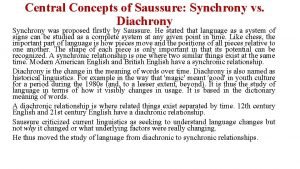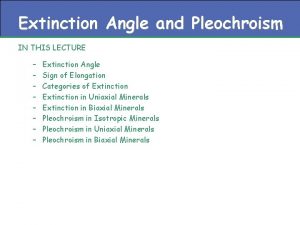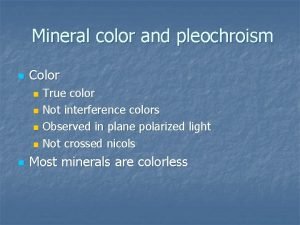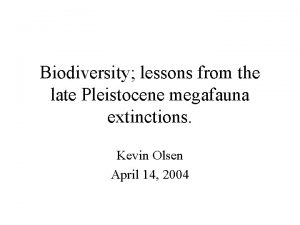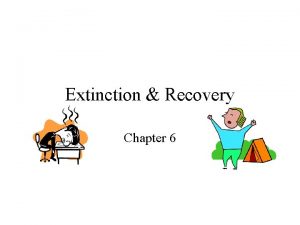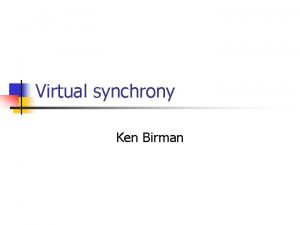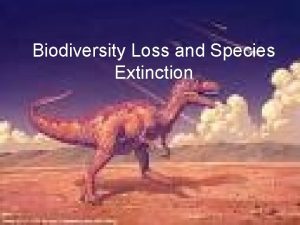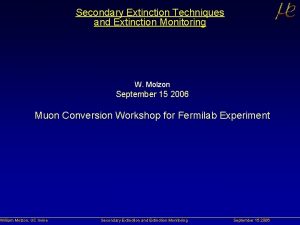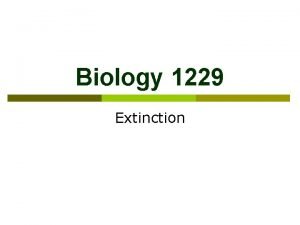Spatial synchrony and extinction risk in metapopulations a



















- Slides: 19

Spatial synchrony and extinction risk in metapopulations: a spatial “hydra effect” Jeremy Fox University of Calgary dynamicecology. wordpress. com David Vasseur Yale University

The “hydra effect”

Metapopulation persistence time The usual story: intermediate dispersal rates maximize metapopulation persistence Indep. patches (async. ) Coloniz. -extinction (async. ) “One big patch” (sync. ) Big patch persistent Big patch extinction-prone Zero/low Intermediate Dispersal rate High

Intermediate dispersal rates maximize metapopulation persistence Yaari et al. 2012

Intermediate dispersal maximizes metapopulation persistence Huffaker 1958 Holyoak and Lawler 1996:

Protist microcosms: a model system for spatial synchrony Euplotes patella Tetrahymena pyriformis

Prey density (ml-1) Cyclic dynamics are easily synchronized (“phase locked”) by dispersal 1500 0 0 72 0 Day 72 • Dispersal rates <0. 5%/prey generation can give synchrony Vasseur & Fox 2009; Fox et al. 2011, unpublished

Spatial synchrony in nature Measles Lynx Gypsy moth Collared lemming Wren Blasius et al. 1999, Johnson et al. 2006, Rohani et al. 1999, Paradis et al. 2000, Krebs et al. 2002

A puzzle: How are asynchronous colonization-extinction dynamics possible? An answer: A spatial hydra effect Local extinctions are desynchronizing • Anything that reduces synchrony promotes recolonization, and thus persistence • Empirical examples of colonization-extinction dynamics involve extinction-prone subpopulations • Empirical examples of synchrony at low dispersal rates involve persistent subpopulations

An illustration of the spatial hydra effect • Nicholson-Bailey host-parasitoid model with demogr. stochas. (Yaari et al. 2012) • 4 patches • Global density-independent dispersal of both spp. after births & deaths • At end of timestep: random subpop. destruction

Host subpopulation abundance Subpopulation dynamics under low dispersal, no subpop. destruction Timestep

Host subpopulation abundance Subpopulation dynamics under intermediate dispersal, no subpop. destruction Timestep

Host subpopulation abundance Subpopulation dynamics under high dispersal, no subpop. destruction Timestep

Host subpopulation abundance Subpopulation dynamics under high dispersal with random subpopulation destruction Timestep

Metapopulation persistence time (mean) A spatial hydra effect 90 Subpopulation destruction rate 0 0. 025 0. 075 0. 1 0 0. 0001 0. 1 Dispersal rate (log scale) 1

Conclusions and future directions • Hydras are real Really exists. • Effect can vary in strength, be swamped by other effects -Matter & Roland 2010 Proc Roy Soc B • Biological details only matter via effects on colonization and extinction rates

Mean metapop. persist. time Weak spatial hydra effect 800 Stochastic Ricker Stochastic logistic map Destruct. rate 0 0. 025 0. 075 0. 1 0 0 1 0 Dispersal rate 1

Low rates of “stepping stone” dispersal phase lock entire metapopulations Mean prey synchrony ±SE 1. 8 Moran Disp. n n y y y 0. 9 0 1 2 3 4 Spatial lag 5 Fox et al. 2011 Ecol. Lett.

Even low dispersal rates can rapidly synchronize cycling populations Fox et al. unpublished
 Background extinction rate definition
Background extinction rate definition Spatial data vs non spatial data
Spatial data vs non spatial data Synchrony diachrony
Synchrony diachrony Market risk assessment
Market risk assessment Bernd schmitt customer experience management
Bernd schmitt customer experience management Cincom synchrony
Cincom synchrony Extinction angle is the angle between
Extinction angle is the angle between Residual risk and secondary risk pmp
Residual risk and secondary risk pmp Business risk vs financial risk capital structure
Business risk vs financial risk capital structure Attributable risk formula
Attributable risk formula Population attributable risk
Population attributable risk Plagioclase extinction angle
Plagioclase extinction angle Simultaneous extinction
Simultaneous extinction Extinction burst adalah
Extinction burst adalah True color of mineral
True color of mineral Ignition extinction curve
Ignition extinction curve Response blocking vs extinction
Response blocking vs extinction Extinction vortex
Extinction vortex Current background extinction rate
Current background extinction rate Simultaneous extinction
Simultaneous extinction


